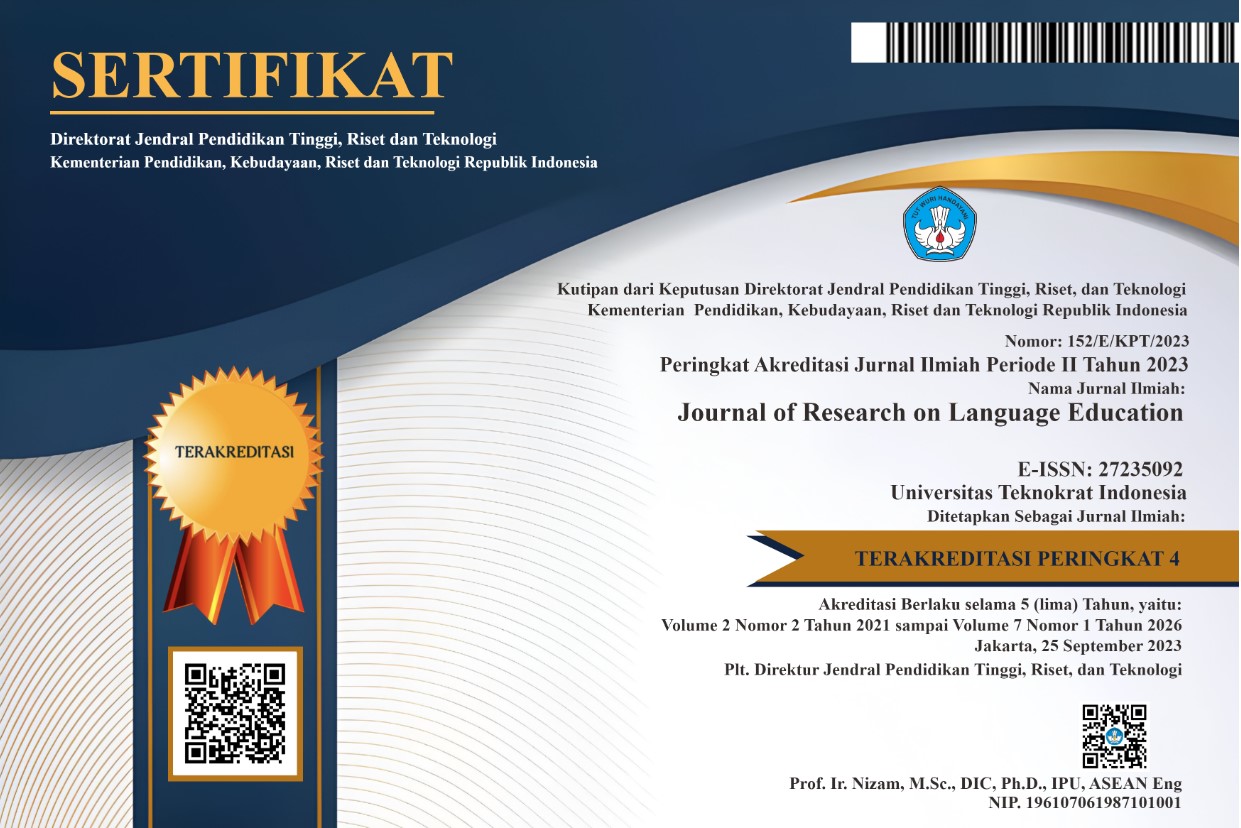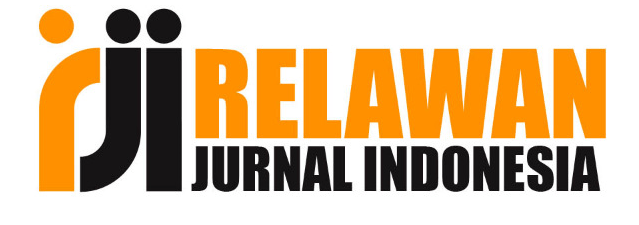INCORPORATING BLENDED LEARNING APPROACH INTO THE INTENSIVE ENGLISH COURSE
Abstract
Keywords
Full Text:
PDFReferences
Alonso, F., López, G., Manrique, D., & Viñes, J.M. (2005). An instructional model for web‐based e‐learning education with a blended learning process approach, British Journal of educational technology, 36(2), pp.217-235, https://doi.org/10.1111/j.1467-8535.2005.00454.x
Barker, J. & Gossman, P. (2013). The learning impact of a virtual learning environment: students’ views. Tacher Education Advancement Network Journal (TEAN), 5(2). pp.19-38, https://insight.cumbria.ac.uk/id/eprint/1455
Bonk, C.J., Olson, T.M., Wisher, R.A. & Orvis, K.L. (2002). Learning from focus groups: An examination of blended learning, International Journal of E-Learning & Distance Education, 17(3), pp.97-118, https://www.ijede.ca/index.php/jde/article/view/299
Brush, T., Glazewski, K., Rutowski, K., Berg, K., Stromfors, C., Hernandez Van-Nest, M., Stock, L. & Sutton, J. (2003). Integrating technology in a field-based teacher training program: The PT3@ ASU project, Educational Technology Research and Development, 51(1), pp.57-72, https://doi.org/10.1007/BF02504518
Cohen, E.G. & Lotan, R.A. (2014). Designing Groupwork: Strategies for the Heterogeneous Classroom Third Edition. Teachers College Press
Collis, B. & Moonen, J. (2001). Flexible learning: It’s not just about distance. In Collis, B. & Moonen, J. Flexible learning in a digital world: Experiences and expectations. New York: Routledge, pp. 8-28.
Collis, B. (1998). New didactics for university instruction: why and how?, Computers & Education, 31(4), pp.373-393, https://doi.org/10.1016/S0360-1315(98)00040-2
Dalziel, J. (2007). Building communities of designers, In Beetham, H. & Sharpe, R. Rethinking pedagogy for a digital age. Oxon: Routledge, pp. 193-206.
Dörnyei, Z. (2001). Motivational Strategies in the Language Classroom. Cambridge: Cambridge University Press.
Dörnyei, Z. (2002). The motivational basis of language learning tasks, In Robinson, P. Individual differences and instructed language learning, Amsterdam: John Benjamin Publishing. pp.137-158.
Ellis, R. (2003). Task-based language learning and teaching. Oxford: Oxford University Press.
Emelyanova, N. & Voronina, E. (2014). Introducing a learning management system at a Russian university: Students' and teachers' perceptions, The International Review of Research in Open and Distributed Learning, 15(1), pp. 272-289, https://doi.org/10.19173/irrodl.v15i1.1701
Eydelman, N. (2013). A blended English as a Foreign Language academic writing course, In Tomlison, B. & Whittaker, C. Blended learning in English Language Teaching: Course Design and Implementation. London: British Council, pp. 43-50.
Feng Su (2019). Blended Learning Pedagogy in Higher Education. In M.A. Peters, R. Heraud (Eds.), Encyclopedia of Educational Innovation, pp.1-6, https://doi.org/10.1007/978-981-13-2262-4_19-1
Garrison, D.R. and Kanuka, H. (2004). Blended learning: uncovering its transformative potential in higher education. The internet and higher education, 7(2), pp.95-105, https://doi.org/10.1016/j.iheduc.2004.02.001
Gilbert, J. (2013). A collaborative online reading and research project, In Tomlison, B. & Whittaker, C. Blended learning in English Language Teaching: Course Design and Implementation. London: British Council, pp. 27-34.
Graham, C.R. (2006). Blended learning systems: definition, current trends, and future directions, In. Bonk, C.J. & Graham, C.R., The handbook of blended learning: Global perspectives, local designs. San Fransisco: John Wiley & Sons. pp. 3-21.
Graham, C. R., Woodfield, W., & Harrison, J. B. (2013). A framework for institutional adoption and implementation of blended learning in higher education. Internet and Higher Education, 18, pp.4–14, https://doi.org/10.1016/j.iheduc.2012.09.003
Hattie, J. & Timperley, H. (2007). The power of feedback. Review of educational research, 77(1), pp.81-112, https://doi.org/10.3102/003465430298487
Hockly, N. (2018). Blended learning. ELT Journal, 72(1), pp. 97-101, https://doi.org/10.1093/elt/ccx058
Jones, C. (2007). Designing for practice: practising design in the social science, In Beetham, H & Sharpe, R. Rethinking Pedagogy for A Digital Age. Oxon: Routledge, pp.166-179.
Jonker, H., März, V. & Voogt, J. (2020). Curriculum flexibility in a blended curriculum. Australasian Journal of Educational Technology, 36(1), pp. 68-84, https://doi.org/10.14742/ajet.4926
Lonn, S. & Teasley, S.D. (2009). Saving time or innovating practice: Investigating perceptions and uses of Learning Management Systems, Computers & Education, 53(3), pp.686-694, https://doi.org/10.1016/j.compedu.2009.04.008
Marjanovic, O., (1999). Learning and teaching in a synchronous collaborative environment, Journal of Computer Assisted Learning, 15(2), pp.129-138, https://doi.org/10.1046/j.1365-2729.1999.152085.x
Mayes, T. & De Freitas, S. (2007). Learning and e-learning: the role of theory, In Beetham, H & Sharpe, R. Rethinking Pedagogy for A Digital Age. Oxon: Routledge, pp.13-25.
Mayes, T. & De Freitas, S. (2004). Review of e-learning theories, frameworks and models. JISC e-learning models study report. JISC e-learning models study report. The Joint Information Systems Committee, London, UK.
McLoughin, C. & Lee, M.J. (2007). Social software and participatory learning: Pedagogical choices with technology affordances in the Web 2.0 era, In ICT: Providing choices for learners and learning. Proceedings ascilite Singapore 2007, pp. 664-675.
Motteram, G. & Sharma, P. (2009). Blending learning in a web 2.0 world, International Journal of Emerging Technologies and Society, 7(2), pp.83.
Pombo, L., Loureiro, M.J., & Moreira, A. (2010). Assessing collaborative work in a higher education blended learning context: strategies and students' perceptions, Educational Media International, 47(3), 217 — 229, http://dx.doi.org/10.1080/09523987.2010.518814
Ravenscroft, A. & Cook, J. (2007). New horizons in learning design, In Beetham, H & Sharpe, R. Rethinking Pedagogy for A Digital Age. Oxon: Routledge, pp.208-218.
Ross, B. & Gage, K. (2006). Global perspectives on blending learning, In Bonk, J. C. Graham, R. C.(Eds.), The handbook of blended learning, pp.155-168.
Sharma, P. (2010). Blended learning. ELT Journal, 64(4), pp. 456-45, https://doi.org/10.1093/elt/ccq043
Vygotsky, L.S. (1978). Mind in society: The development of higher mental process. Cambridge: Harvard University Press.
Weller, M. (2007). Virtual Learning Environments. New York: Routledge.
Yang, Y.T.C. Chuang, Y.C., Li, L.Y. & Tseng, S.S., (2013). A blended learning environment for individualized English listening and speaking integrating critical thinking, Computers & Education, 63, pp.285-305, https://doi.org/10.1016/j.compedu.2012.12.012
DOI: https://doi.org/10.33365/jorle.v3i2.2155
Refbacks
- There are currently no refbacks.

This work is licensed under a Creative Commons Attribution-NonCommercial-ShareAlike 4.0 International License.

Articles published in Journal of Research on Language Education is licensed
under a Creative Commons Attribution-ShareAlike 4.0 International License.
English Education Study Program, Faculty of Arts and Education.
Universitas Teknokrat Indonesia
Zainal Abidin Pagaralam 9-11 Bandar Lampung, Indonesia
All rights reserved.








